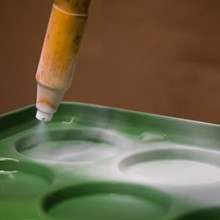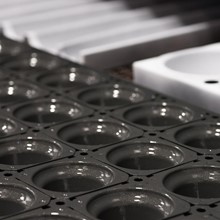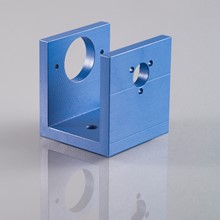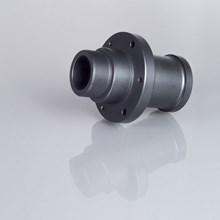We've created this handy glossary to help demystify some of the terminology used when talking about our coating solutions. If you have any further questions about what we do or our coating process, please feel free to contact our technical experts with your questions.
Galling is the wear caused by the friction or adhesion of two surfaces sliding against each other. Materials such as PTFE can reduce the impact of galling, which extends the lifespan of the component.
A substance that is inert is not chemically reactive. This means that chemically inert coatings would be suitable for environments that expose them to otherwise damaging chemicals.
The coefficient of friction is a value that represents the relationship between the force of friction of an object, and it's normal reaction. This number is usually between 0 (no friction) and 1 (normal friction), but it can be higher than 1 (in cases where the force applied creates more fiction).
Non stick coatings have a low coefficient of friction (<0.1).
This refers to how likely a solid material will move slowly or deform under load. Over time, some materials may deform even though they are exposed to levels of stress within their intended tolerances and cold flow can also be affected by temperature.
A material's dielectric strength indicates the electric field that it can withstand before breaking down.
Dissipation factor is a measure of the loss of energy from the material.
Dry lubricants are materials which can reduce the friction between surfaces without the need for a liquid to be used. Examples of these materials are PTFE, graphite and molydisulfide.
DuPont invented PTFE in 1938 and went on to release Teflon coatings a few years later. Teflon is now owned by Chemours.
ECTFE is a fluoropolymer was designed to provide better chemical resistance for applications exposed to more corrosive environments. ECTFE is a brand name of the company Halar.
ETFE coatings are a copolymer of Ethylene and TetraFluoroEthylene better known as Tefzel. Although not fully fluorinated, ETFE coatings have excellent chemical resistance and can operate at 150°C/300°F.
FEP differs from PTFE as it is melt-processable which means it can be used to produce smooth, non-porous coatings with excellent abrasion resistance.
Film thickness refers to the thickness (or minimum possible thickness) of the material used for the coating.
A fluorocarbon based polymer. In 1938, PTFE was discovered (branded "Teflon" by the company that created it), the first fluoropolymer which is characterised by a high resistance to solvents, acids and bases. PFA, FEP, ETFE and ECTFE are other fluoropolymers offered by AFT Fluorotec.
This is the physical property of the material that indicates how able it is to repel water (strictly speaking, it's a lack of attraction rather than repulsion).
This refers to the capability of a material to withstand suddenly applied load.
Non-stick coatings are commonly recognised in the home, particularly as pots and pans are coated with Teflon (a brand of PTFE coating). In industrial use, non stick coatings can be applied to bakeware, food processing, oil & gas applications and many other uses. It's a catch-all term that could refer to a broad range of materials and applications.
This refers to materials that can repel oils. For example, a touch phone screen is oleophobic to repel fingerprint oil.
PEEK coatings are typically used to improve resistance to chemicals, corrosion, abrasion and wear when applied to metal substrates.
PFA coatings melt and flow during baking to provide non-porous films and increased permeation resistance.
When referring coating materials, properties refer to the range of tolerances the final grade of material will have.
PTFE (PolyTetraFluoroEthylene) coatings, often referred to as Teflon or Xylan coatings offer a tough inert heat-resistant finish with almost complete chemical inertness.
This refers to solutions that may be used instead of release coatings. For example, using silicone paper to cover a baking tray for easier removal of products after cooking. Generally, non-stick coatings offer a more robust and cost-effective solution than release agents, particularly when dealing with large quantities of product and multiple cycles of equipment use.
Non-stick coatings that are designed to be used in production and then release the product.
For example, a muffin tray has a non-stick release coating that can withstand high temperatures but won't cause the muffins stick to the tray.
Abrasion resistance is the ability of the material to resist surface wear as a result of contact with another material. PTFE is known for its non-stick properties, but its ability to withstand wear is what makes it useful as a long term solution for coatings.
Chemical resistance refers to a material's ability to withstand and protect against chemical and solvent reactions. PTFE's chemical resistance makes it an excellent choice for sealing applications.
This refers to a material's ability to resistant catching fire. This is particularly important in food industry applications where equipment may be subjected to high temperatures.
A material's ability to withstand force that is applied suddenly or over a short period of time is key for several industries. For example, baking trays may be stacked after use, but this has the potential to cause damage to the tray and reduce its lifespan. The right coating can protect the trays for longer.
Liquids, gases and vapours can permeate equipment and cause it to be damaged if the wrong coating is applied. It's important to understand the environment that the equipment will be used in to best judge which material it should be coated with.
A material's thermal resistance measures the degree by which it resists heat flow. This is particularly important for applications that are exposed to temperatures that may affect the equipment being coated.
Wear is the measurement of the impact of continuous friction between two surfaces which can cause the removal or deformation of the materials. In situations where the equipment will be subject to wear, it's important that the coating used is best suited for the job.
Sintering is the process of coalescing materials (through heat or pressure) so they form into a solid material. This process is used for applications that require the material to have a specific porosity.
The specific gravity of a substance is the ratio of density of it compared to a reference substance.
The substrate is the underlying layer that the coating is applied to.
This is the process of blast cleaning the surface of an item in preparation for the coating to be applied. This is carried out to ensure that the coating is of a high quality.






